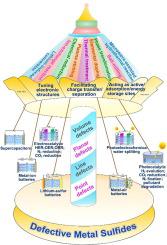Coordination Chemistry Reviews ( IF 20.6 ) Pub Date : 2021-08-27 , DOI: 10.1016/j.ccr.2021.214147 Yingge Zhang 1 , Yihe Zhang 1 , Hanfang Zhang 1 , Liqi Bai 1 , Lin Hao 1 , Tianyi Ma 2 , Hongwei Huang 1

|
Defect engineering is regarded as one of the efficient approaches to modulating the physical and chemical properties of materials for energy-related applications. Metal sulfides (MSs) have increasingly aroused research concerns in energy conversion and storage fields for their tunable electronic structure, semiconducting traits and outstanding redox reversibility. Therefore, introducing defects into MSs is considered to be a promising way to construct highly-efficient materials for energy conversion and storage. However, the reviews about the comprehensive applications of defective MSs for the above application are rare. Herein, this review first summarizes different types of defects, including vacancies, doping, edge/screw dislocation, grain/twin boundaries, lattice disorders and voids, and diverse synthetic strategies, such as thermal treatment, plasma etching, elemental doping, chemical reduction, and phase transformation in MSs. More importantly, we elaborately discuss the diversified applications of the defective MSs in photocatalytic H2 evolution, CO2 reduction, N2 fixation, pollutant degradation, electrocatalytic H2 evolution, O2 evolution, O2 reduction, CO2 reduction, N2 reduction, photoelectrochemical water splitting, metal-ion/air batteries, lithium-sulfur batteries and supercapacitors. Finally, the current challenges and future perspectives for precisely synthesizing defective MSs (either with diverse defects or multinary MSs) applied in interdisciplinary domains and their advanced characterization techniques are also proposed.
中文翻译:

用于能量转换和存储的金属硫化物缺陷工程
缺陷工程被认为是调节能源相关应用材料物理和化学性质的有效方法之一。金属硫化物(MSs)因其可调谐的电子结构、半导体特性和出色的氧化还原可逆性而越来越引起能量转换和存储领域的研究关注。因此,将缺陷引入 MS 被认为是构建高效能量转换和存储材料的一种有前景的方法。然而,针对上述应用的缺陷 MS 的综合应用的评论很少。在此,这篇综述首先总结了不同类型的缺陷,包括空位、掺杂、边缘/螺旋位错、晶粒/孪晶界、晶格紊乱和空隙,以及各种合成策略,例如热处理、MS 中的等离子体蚀刻、元素掺杂、化学还原和相变。更重要的是,我们精心讨论了缺陷 MSs 在光催化 H 中的多样化应用。2演化、CO 2还原、N 2固定、污染物降解、电催化H 2演化、O 2演化、O 2还原、CO 2还原、N 2还原、光电化学水分解、金属离子/空气电池、锂硫电池和超级电容器。最后,还提出了精确合成应用于跨学科领域的有缺陷的 MS(具有多种缺陷或多元 MS)及其先进表征技术的当前挑战和未来前景。



























 京公网安备 11010802027423号
京公网安备 11010802027423号